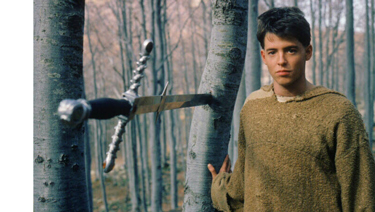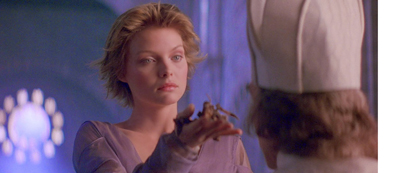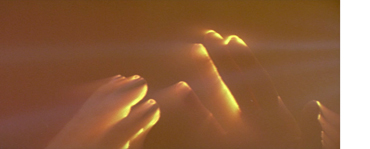
 |
|
|
|
(non-spoiler review) Ladyhawke is the most entertaining post- Superman film by the capable Richard Donner, who a couple of years later found a commercial groove with his Lethal Weapon movies. Filmed on a dozen beautiful Italian locations, the medieval action fable is a fast favorite of legions of fans who saw it at a young age. It's the third picture of star Matthew Broderick and an excellent vehicle for Rutger Hauer and Michelle Pfeiffer, who play a dazzling romantic couple kept from sharing the screen together until the final minutes of the movie. Seeing Ladyhawke on Warners' new Blu-ray erases memories of old flat cable presentations. Donner's direction is as precise as ever but Vittorio Storaro's cinematography is dazzling... he puts his color experimentation ideas to good use. 
Pickpocket Gaston, known as 'The Mouse' (Matthew Broderick) is fortunate to escape from the dungeon of The Bishop (John Wood) just before the Bishop's knights choose him for one of their arbitrary executions. Loose in the woods, Gaston evades the knights with the aid of errant rogue knight Navarre (Rutger Hauer), who has an unusually close relationship to his hunting hawk. At night, Navarre disappears but Gaston meets the mysterious woman Isabeau (Michelle Pfeiffer), who asks him questions about the blonde knight. And there's also a black wolf prowling about in the dark. What's going on? Gaston doesn't find out until the Hawk is struck by an arrow, and Navarre sends him to see the monk Imperius (Leo McKern). While healing the bird, Imperius describes a horrible curse put upon Navarre and Isabeau by the Bishop, who is actually a necromancer mad with jealousy. Imperius feels responsible for the curse (it's a long story), and has discovered a way to break the spell. But Navarre won't listen to him. He insists that his mission is to kill the Bishop, which will make the spell permanent. Gaston becomes an unusual go-between, conveying the endearments of lovers that can never meet. In Ladyhawke Richard Donner and Co. by and large succeed in a making an old-fashioned knights in armor fantasy that works. The thanks go to Edward Khmara's original concept, which is worthy of Hans Christian Andersen. It's so good that Ladyhawke attains an epic feel without scenes of vast armies or mass gatherings of costumed extras. Remember Billy Wilder's Hollywood drama Sunset Blvd.? In it a writer describes a story idea for a perfect 'meet cute' romance. A day school teacher and a night school teacher share the same classroom but never see each other. They fall in love just by observing how the other leaves the room behind, perhaps with a little flower on a table, or a note on the blackboard. The romantic tension comes from keeping the lovers completely separate. Ladyhawke takes this idea to a fantasy extreme. 
It's really a small story with big characters. Action at the court is barely sketched, with The Bishop dispatching his unhappy officers to kill our heroes, the victims of his curse. There are escapes, chases and the expected fights, plus the wounding of Navarre's beautiful hunting bird, and its healing up at Imperius's hilltop retreat. Broderick is a pleasant enabler for all aspects of the show, a thief and trickster always complaining that telling the truth gets him nowhere. Broderick sometimes affects a slight English accent, and sometimes not. To some degree the dialogue is cute-sified, as was the case in the 1990s when Han Solo / Indiana Jones screwball quips were in vogue. Some of these fall flat but Broderick's charm carries through. Someone reviewed old movies when writing the script, for the Bishop's knights disguise themselves at a country inn just like Richard the Lionhearted does in the old Errol Flynn The Adventures of Robin Hood. Rutger Hauer oozes strength and determination. His knight's code of goodly honor ignores the light cynicism of the Spielberb/Lucas pulp retro films. Navarre is one-dimensional but also soulful. He's not perfect, like Franco Nero in Camelot, which is very good. Michelle Pfeiffer is in non-smiley mode, which brings more attention to her classical beauty and captivating eyes. Definitely a top star of the decade, she carries a role that's thinly written yet compelling. The nature of the curse on Navarre and Isabeau makes us especially care what happens to them. 
Ladyhawke commands our attention simply for how good it looks. Donner and Storaro give us handsome images at all times; Storaro has the knack of making sharp images look even sharper, and every scene has an interesting approach to color. A woodland episode with multi-colored leaves makes us think that everything is slightly artificial, but this is before the digital manipulation of images. Due to the nature of the story many scenes happen in the twilight before sunset or dawn. Storaro makes them interesting through selective color timing -- clinging to the ground, Gaston and everything around him are very blue, with a single bright yellow orange rim-light on his hair to indicate the rising sun. When effects are brought into use for special transformations, Storaro keeps everything as impressionistic as possible. Yes, we see simple dissolves, but another effect simply shows some fingers moving in an odd light. It's just as magical as any zillion-dollar CGI composite. The show ends with the expected confrontations, battles and success plucked from the despair of failure. This part of the movie is less memorable, if only because the prime villain The Bishop is rather colorless. He's never given an opportunity to express his love for Isabeau, so we have to assume that he's just a selfish b-- who doesn't like young lovers to be happy. 
A fairy tale story like Ladyhawke can have a grand symphonic music score or no music at all, it all depends on the taste of the filmmaker. It doesn't have to be accurate to the period, as musical melodies from the middle ages are limited at best. The instruments used don't have to be era-appropriate either, as composers like Jerry Goldsmith often introduce electronic moods and pop beats into period pictures, with great success. The Klaus Doldinger/Giorgio Moroder music on the previous year's The NeverEnding Story is memorably effective. Unfortunately, the release version of Ladyhawke carries a pop score with a disco beat that clashes with the elegant, high-class images on screen. Every time somebody goes into action, the drum machine starts up as if the audience is supposed to leap to its feet and rock out. Other passages use more conventional string orchestrations, and I'll admit that those cues aren't particularly memorable either. The disco beat stuff must have been jarring in 1985, and I think it would be laughed off the screen now. Did Richard Donner or Warners have cold feet, and decide that the movie needed the upbeat music track from a Jane Fonda workout session? It's a good thing that Ladyhawke scores so high in every other regard. The animals alone are a pleasure to watch -- the hawk and the wolf are impressive, and Navarre's black horse will be the handsomest steed on Blu-ray until The Black Stallion arrives later this year. |
|||||||||||||||||||
Review Staff | About DVD Talk | Newsletter Subscribe | Join DVD Talk Forum
Copyright © MH Sub I, LLC dba Internet Brands. | Privacy Policy
Subscribe to DVDTalk's Newsletters
|